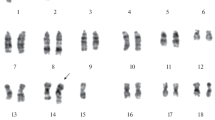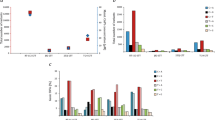Abstract
Chromosomal analysis of 26 Djungarian hamster cell lines obtained from 11 independent clones and possessing different levels of resistance to colchicine or adriablastin as a consequence of gene amplification revealed regular patterns in the karyotypic changes that accompanied the development of drug resistance. Usually the sequence of karyotypic changes was as follows: first an additional chromosome 4 appeared; then single unpaired small chromatin bodies (SCBs) arose; later in the middle part of the long arm of one of three chromosomes 4 long homogeneously staining regions (HSRs) and double minute chromosomes (DMs) were formed; and finally in the most resistant variants large clusters of SCBs appeared. The emergence of the clusters of the SCBs correlated well with the occurrence of autonomously replicating, amplified DNA sequences. In contrast to DNA of the HSRs the DNA of the SCBs could replicate outside the S-phase of the cell cycle. When kept in a non-selective medium, the cells gradually lost their resistance to colchicine: 1%–4% of the cells lost the capacity to form colonies in the selective medium independently of the pattern of location in them of amplified genes (in chromosomal HSRs, SCBs, or DMs). Loss of drug resistance was accompanied by disappearance of the chromosomal HSRs, SCBs, and DMs. Chromosomal analysis of the set of methotrexate-resistant Djungarian hamster cell lines indicated the following karyotypic evolution: first the additional material on the distal part of one of two chromosomes 3 appeared; then the light HSRs were formed on the distal part of one of two chromosomes 4; later clusters of SCBs and HSRs arose on the distal part of the short arm of chromosome 3. Probably the amplification of different genes is characterized by specific patterns of karyotypic alterations.
Similar content being viewed by others
References
Alitalo K, Schwab M, Lin CC, Varmus HE, Bishop JM (1983) Homogeneously staining chromosomal regions contain amplified copies of an abundantly expressed cellular oncogene (c-myc) in colon carcinoma. Proc Natl Acad Sci USA 80:1707–1711
Balaban-Malenbaum G, Gilbert FW (1981) The proposed origin of double minutes from homogeneously staining regions (HSR)-marker chromosomes in human neuroblastoma hybrid cell lines. Cancer Genet Cytogenet 2:339–348
Barker PE (1982) Double minutes in human tumour cells. Cancer Genet Cytogenet 5:81–94
Barker PE, Stubblefield E (1979) Ultrastructure of double minutes from a human tumor cell line. J Cell Biol 83:663–666
Barker PE, Drwinga HL, Hittelman WN, Maddox A (1980) Double minutes replicate once during S phase of the cell cycle. Exp Cell Res 130:353–360
Baskin F, Rosenberg RN, Dev V (1981) Correlation of double minute chromosomes with unstable multidrug cross-resistance in uptake mutants of neuroblastoma cells. Proc Natl Acad Sci USA 78:3654–3658
Biedler JL (1982) Evidence for transient or prolonged extrachromosomal existence of amplified DNA sequences in antifolate-resistant, vincristine-resistant, and human neuroblastoma cells. In: Schimke RT (ed) Gene amplification, Cold Spring Harbor Press, New York, pp 39–46
Biedler JL, Spengler BA (1976a) Metaphase chromosome anomaly associated with drug resistance and cell-specific products. Science 191:185–187
Biedler JL, Spengler BA (1976b) A novel chromosome abnormality in human neuroblastoma and antifolate-resistant Chinese hamster cells in culture. J Natl Cancer Inst 57:683–695
Biedler JL, Melera PW, Spengler BA (1980) Specifically altered metaphase chromosomes in antifolate-resistant Chinese hamster cells that overproduce dihydrofolate reductase. Cancer Genet Cytogenet 2:47–60
Bostock CJ, Clark EM, Harding NGL, Mounts PM, Tyler-Smith C, van Heyningen V, Walker PMB (1979) The development of resistance to methotrexate in mouse melanoma cell line. I. Characterization of the dihydrofolate reductases and chromosomes in sensitive and resistant cells. Chromosoma 74:153–177
Bostock CJ, Clark EM (1980) Satellite DNA in large marker chromosomes of methotrexate-resistant mouse cells. Cell 19:709–715
Brown PC, Beverley SM, Schimke RT (1981) Relationship of amplified dihydrofolate reductase genes to double minute chromosomes in unstably resistant mouse fibroblast cell lines. Mol Cell Biol 1:1077–1083
Brown PC, Kaufman RJ, Haber D, Schimke RT (1982) Characteristics of dihydrofolate reductase gene amplification in murine and Chinese hamster ovary cell lines. In: Schimke RT (ed) Gene amplification. Cold Spring Harbor Press, New York, pp 9–14
Chasin LA, Graf L, Ellis N, Landzberg M, Urlaub G (1982) Gene amplification in dihydrofolate reductase-deficient mutants. In: Schimke RT (ed) Gene amplification. Cold Spring Harbor Press, New York, pp 161–167
Cowell JK (1982) Double minutes and homogeneously staining regions: Gene amplification in mammalian cells. Ann Rev Genet 16:21–59
Dolnick BJ, Berenson RJ, Bertino JR, Kaufman RJ, Nunberg JH, Schimke RT (1979) Correlation of dihydrofolate reductase elevation with gene amplification in a homogeneously staining region in L5178Y cells. J Cell Biol 83:394–402
Gall JG, Roshaix J-D (1974) The amplified ribosomal DNA in dytiscid beetles. Proc Natl Acad Sci USA 71:1819–1823
George DL, Powers VE (1981) Cloning of DNA double minutes of Y 1 mouse tumor cells: evidence for gene amplification. Cell 24:117–123
George DL, Powers VE (1982) Amplified DNA sequences in Y 1 mouse tumor cells: association with double minutes and localization to a homogeneously staining chromosomal region. Proc Natl Acad Sci USA 79:1597–1601
Gudkov AV, Massino JS, Chernova OB, Kopnin BP (1985) Gene amplification in Djungarian hamster cells possessing decreased plasma membrane permeability for colchicine and some unrelated drugs. Chromosoma 92:16–24
Haber DA, Schimke RT (1981) Unstable amplification of an altered dihydrofolate reductase gene associated with double minute chromosomes. Cell 26:355–362
Hamlin JL, Biedler JL (1981) Replication pattern of large homogeneously staining chromosomal region in antifolate resistant Chinese hamster cell lines. J Cell Physiol 107:101–114
Kanda N, Schreck R, Alt F, Bruns G, Baltimore D, Latt S (1983) Isolation of amplified DNA sequences from IMR-32 human neuroblastoma cells: Facilitation by fluorescence-activating flow sorting of metaphase chromosomes. Proc Natl Acad Sci USA 80:4069–4073
Kaufman RJ, Brown PC, Schimke RT (1979) Amplified dihydrofolate reductase genes in unstably resistant cells are associated with double minute chromosomes. Proc Natl Acad Sci USA 76:5669–5673
Kaufman RJ, Brown PC, Schimke RT (1981) Loss and stabilization of amplified dihydrofolate reductase genes in mouse sarcoma S-180 cell lines. Mol Cell Biol 1:1084–1093
Kellems RE, Harper ME, Smith L (1982) Amplified dihydrofolate reductase genes are located in chromosome regions containing DNA that replicates during the first half of S-phase. J Cell Biol 92:531–539
Kuo T, Pathak S, Ramagli L, Rodriguiz L, Hsu TC (1982) Vincristine-resistant Chinese hamster ovary cells. In: Schimke RT (ed) Gene amplification. Cold Spring Harbor Press, New York, pp 53–57
Levan A, Levan G (1978) Have double minutes functioning centromeres? Hereditas 88:81–92
Levan A, Levan G, Mandahl N (1978) A new chromosome type replacing the double minutes in a mouse tumor. Cytogenet Cell Genet 20:12–23
Levan G, Levan A (1982) Transitions of double minutes into homogeneously staining regions and C-bandless chromosomes in the SEWA tumors. In: Schimke RT (ed) Gene amplification. Cold Spring Harbor Press, New York, pp 91–97
Lewis JA, Davide JP, Melera PW (1982) Selective amplification of polymorphic dihydrofolate reductase gene loci in Chinese hamster lung cells. Proc Natl Acad Sci USA 79:6961–6965
Melera PW, Lewis JA, Biedler JL, Hession C (1980) Antifolate-resistant Chinese hamster cells. Evidence for dihydrofolate reductase gene amplification among independently derived sublines overproducing different dihydrofolate reductases. J Biol Chem 255:7024–7028
Meyers MB, Biedler JL (1981) Increased synthesis of low molecular weight protein in vincristine-resistant cells. Biochem Biophys Res Comm 99:228–235
Milbrandt JD, Heintz NH, White WC, Rothman SM, Hamlin JL (1981) Methotrexate-resistant Chinese hamster ovary cells have amplified a 135-kilobase-pair region that includes the dihydrofolate reductase gene. Proc Natl Acad Sci USA 78:6043–6047
Miller OJ, Tantravahi R, Miller DA, Yu LC, Scabo P, Prensky W (1979) Marked increase in ribosomal RNA gene multiplicity in a rat hepatoma cell line. Chromosoma 71:183–195
Nunberg JH, Kaufman RJ, Schimke RT, Urlaub G, Chasin LA (1978) Amplified dihydrofolate reductase genes are localized to a homogeneously staining region of a single chromosome in a methotrexate-resistant Chinese hamster ovary cell line. Proc Natl Acad Sci USA 75:5553–5556
Özknay C, Mitelman F (1979) Simple trypsin Giemsa technique producing simultaneous G- and C-banding in human chromosomes. Hereditas 90:1–4
Schimke RT, Brown PC, Kaufman RJ, McGrogan M, Slate DL (1981) Chromosomal and extrachromosomal localization of amplified dihydrofolate reductase genes in cultured mammalian cells. Cold Spring Harbor Symp Quant Biol 45:785–796
Schwab M, Alitalo K, Varmus HE, Bishop JM, George D (1983a) A cellular oncogene (c-Ki-ras) is amplified, overexpressed, and located within karyotypic abnormalities in mouse adrenocortical tumor cells. Nature 303:497–501
Schwab M, Alitalo K, Klempnauer K-H, Varmus HE, Bishop JM, Gilbert F, Brodeur G, Goldstein M, Trent G (1983b) Amplified DNA with limited homology to myc cellular oncogene is shared by human neuroblastoma cell lines and neuroblastoma tumour. Nature 305:245–248
Simonsen CC, Brown PC, Crouse GF, McGrogan M, Setzer D, Sweetser D, Kaufman RJ, Schimke RT (1981) Gene amplification as a mechanism for drug resistance in cultured animal cells. In: Singer Ondarza, (ed) Molecular basis of drug action. Elsevier North Holland Inc, pp 743–759
Tyler-Smith C, Bostock CJ (1981) Gene amplification in methotrexate-resistant mouse cells. III. Interrelationships between chromosome changes and DNA sequence amplification and loss. J Mol Biol 153:237–256
Wahl GM, Allen V, Delbrück S, Eckhart W, Meinkoth J, Padgett R, de Saint Vincent BR, Rubnitz J, Stark G, Vitto L (1982) Analysis of CAD gene amplification using molecular cloning, gene transfer and cytogenetics. In: Schimke RT (ed) Gene amplification, New York, Cold Spring Harbor Press, pp 167–176
Author information
Authors and Affiliations
Rights and permissions
About this article
Cite this article
Kopnin, B.P., Massino, J.S. & Gudkov, A.V. Regular pattern of karyotypic alterations accompanying gene amplification in Djungarian hamster cells: study of colchicine, adriablastin, and methotrexate resistance. Chromosoma 92, 25–36 (1985). https://doi.org/10.1007/BF00327242
Received:
Revised:
Issue Date:
DOI: https://doi.org/10.1007/BF00327242




